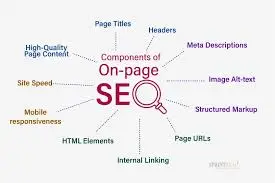Search Engine Optimization (SEO)
Search Engine Optimization (SEO) is an essential digital marketing strategy that helps businesses improve their visibility on search engines like Google, Bing, and Yahoo. By optimizing your website and content for search engines, you increase the chances of attracting more organic traffic, boosting your online presence, and ultimately driving more sales or conversions. This guide explores the key components of SEO, providing actionable tips to improve your rankings effectively.
What is SEO?
SEO stands for Search Engine Optimization. It involves optimizing your website and content to make them more appealing to search engines and their algorithms. The goal is to achieve higher rankings on search engine results pages (SERPs) for relevant keywords or phrases that your target audience is searching for.

Why is SEO Important?
- Increased Visibility: Higher rankings mean more visibility, which leads to increased brand awareness.
- Organic Traffic: SEO drives unpaid traffic, reducing your reliance on paid ads.
- Cost-Effective: SEO is a long-term investment compared to paid advertising.
- Credibility and Trust: Ranking high in search results boosts your credibility with users.
- Competitive Edge: A well-optimized website can help you outperform competitors.
Types of SEO
SEO can be categorized into several types, each addressing specific aspects of website optimization:
1. On-Page SEO
On-page SEO focuses on optimizing individual web pages for search engines and users.
- Keywords: Use relevant keywords naturally in titles, headers, and content.
- Meta Tags: Write compelling meta titles and descriptions for better CTR (Click-Through Rate).
- URL Structure: Keep URLs concise and include keywords.
- Content Optimization: Create high-quality, informative, and engaging content.
- Internal Linking: Link to other pages within your site to improve navigation and SEO.

2. Off-Page SEO
Involves actions taken outside of your own website to impact rankings.
Includes:
Link building (backlinks from other websites)
Social media marketing
Influencer outreach
Brand mentions

3. Technical SEO
Focuses on the backend structure of a website to help search engines crawl and index it properly.
Includes:
Website speed and performance
Mobile-friendliness
XML sitemaps
Secure site (HTTPS)
Fixing crawl errors and broken links

4. Local SEO
Optimizes a website to attract traffic from location-based searches.
Includes:
Google My Business optimization
Local keywords
Online reviews and ratings
Local backlinks

5. E-commerce SEO
Tailored specifically for online stores.
Includes:
Optimizing product pages
Category structure
Schema markup for products
Customer reviews
